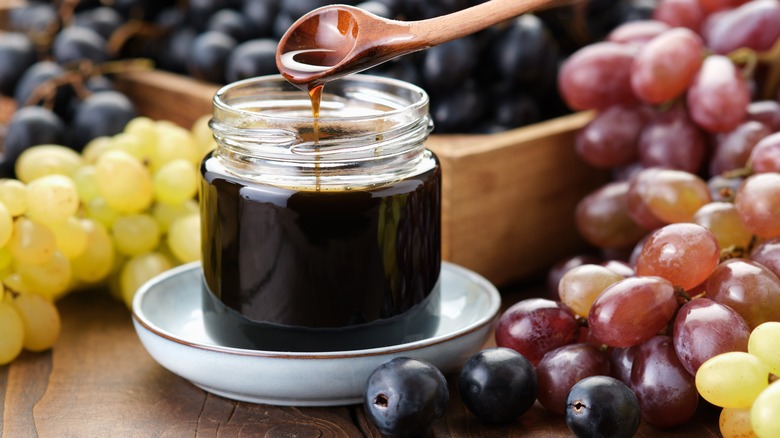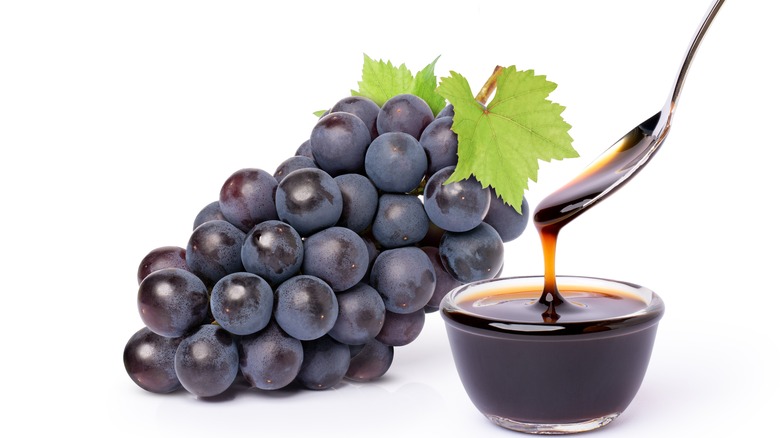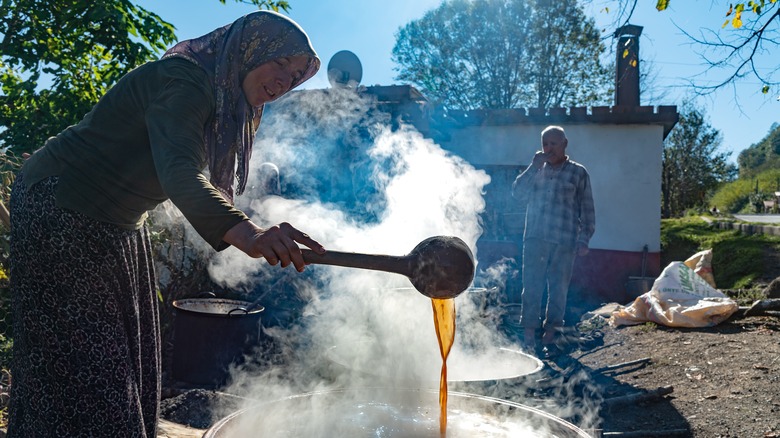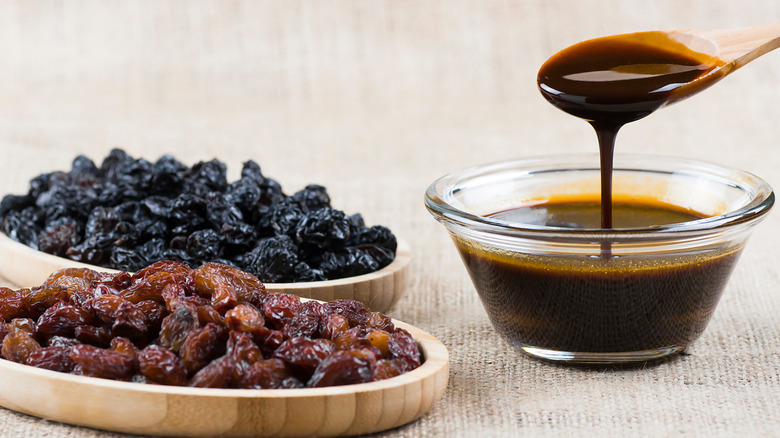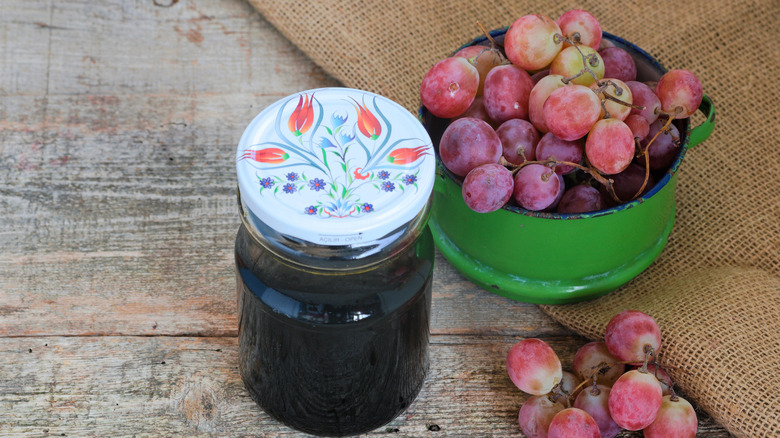What Is Grape Molasses And How Do You Cook With It?
Grapes — when not eaten fresh, they're most infamously processed into wine or vinegar. However, in Mediterranean countries, other grape extracts are popular too. The first step of wine-making is the production of grape must, which is a pressed juice that contains the fruit's seeds and stems. While this thick liquid is more frequently fermented into wine, it's also consumed on its own. With around 15% sugar content, it's sweet and tasty, but not particularly stable. So to improve shelf-life, it's reduced down to around a third of its volume, and voilà — grape molasses is created.
Consumed since as early as the Bronze Age, this simple food is easy to fall for. Thick and syrupy, it resembles fruit-like honey, but with just an undertone of bitterness. Plus, it's wonderfully malleable, perfect for integration into a wide variety of dishes. No surprise such qualities have earned it the status of a pantry staple. Let's dive into what it's all about.
Varieties of grape molasses
Grape molasses goes by several names, with many variations in production. Its most common form is in Turkey and Greece, where it's known as "petimezi" and "pekmez." The variety produced in these regions typically features ash as a flavoring component. In Italy, it's processed with walnuts and has a less acidic flavor. Called "saba," some believe the food is a proto-version of balsamic vinegar. In fact, it makes an inexpensive substitution for top-of-the-line kinds of vinegar.
In Spain, it's referred to as "arrope" and added as a component to wines — usually sweeter and more fortified varieties such as sherry and marsala. English-speaking winemakers simply referred to it as grape concentrate. Intermingling with many cultures produced a diversity of names, like "grape honey" or "dibs" in Israel. Not surprisingly, since grape molasses has been produced for thousands of years, it was even mentioned by Hippocrates in B.C. times.
How is grape molasses made?
Grape molasses starts from grape must, which is a form of grape juice extracted through a specific kind of press and a strainer. To make the molasses, the resultant liquid is reduced until it reaches a syrupy consistency. Grape molasses can be created using only grapes, although some choose to add extra flavors like spices, herbs, and lemon. In traditional preparation, sugar is not added because the grapes contain enough to create a thick liquid. And in old-school preparations, a small amount of pure ash is added to balance the acidity.
The best grape molasses stars with fresh grapes, which are collected with leaves, and any impurities removed. Next, grape juice is pressed through a cheesecloth and brought to a boil. Any impurities are removed from the top, and the juice is then simmered down for approximately an hour until it reduces in volume by half. It can then be transferred into well-sanitized jars, which will store for several months.
How to cook with grape molasses
This berry-derived molasses is a pantry staple in the Mediterranean, integrated into a large variety of dishes as a sweetener. In Turkey, it's mixed with tahini for a quick breakfast especially popular among children. Meanwhile, in Greece, it's most famously used as a key component in moustokouloura, a vegan cookie made with olive oil instead of dairy or eggs. Much like pomegranate molasses, the grape variety also beautifully integrates into a variety of savory dishes.
It lends well to slow cooking, adding a sweet note to foods like baked beans, roasted vegetables, or braised beef — a dish especially popular in Macedonia. Alternatively, grape molasses can also be employed for a fresh and tangy note. It can replicate the pleasant sweetness of balsamic in a dressing, or add some extra flavor to fresh cheese. For a broader range of applications, consider substituting it into recipes calling for pomegranate molasses. Just keep in mind grape molasses is much less acidic, so add some vinegar or lemon juice to compensate.
Where to find grape molasses
This sweet and sticky substance still hasn't reached the same ubiquity in the U.S. as in the Mediterranean. There are a few online purveyors, which mainly sell imported varieties from Greece or Turkey. Sometimes, it's labeled with a different name — search for "pekmez" or "petimezi" instead. Grape molasses can also be located in specialty Mediterranean groceries. And if you're in a country where this type of syrup is common, simply head to the market. It's widely available around the Mediterranean.
Considering the short ingredient list, it's often easier to make grape molasses at home than to find it. Any grapes are suitable for its creation, although red varieties are preferred for a more appetizing resultant color. The only downside is the required amount of fruit — it'll take nearly four pounds to produce just over 10 ounces of the syrup. So consider making it in a large batch and storing it. In a dry, shaded place, a jar of molasses will keep for up to two years.
